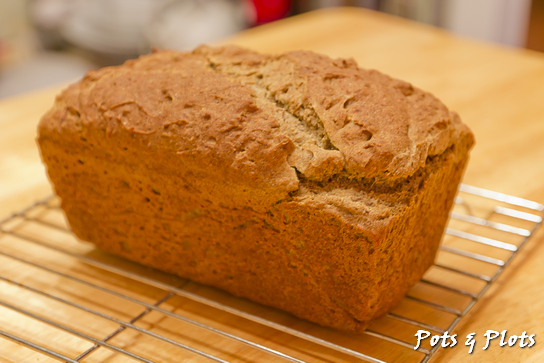One of our favorite foods in this house is sourdough bread. I make it every year for holiday gifts as EVERYONE loves it and it’s easy to make in large quantities (I made 16 regular loaves this year). Well, I got it into my head to try a gluten free version. My google search didn’t bring up much as a basis. Those who had tried it hadn’t had good luck, which, after my own experimentation, I am forced to conclude is because they used funky starter. See, sourdough starter is like a child. It has to be fed. Sugar and some kind of starch, every 5 days, to keep the yeast alive. Several of the gluten free versions (and even non-gluten free) used stuff like flour or different kinds of gf flours to feed it. I have no idea why they would do that as yeast doesn’t seem to much like them and doesn’t produce a happy starter. I just used my original soudough starter which you feed with potato flakes. I mean, this is a no fail starter. I’ve never had it die on me unless I forget to feed it on time. Now of course regular sourdough does not have baking powder, but we all know that with gluten free baking you sometimes need a little help to get things to rise enough. I’ve made four loaves of this so far, with multiple small variations in the gluten free flours and all came out beautifully, so I give to you with confidence, gluten free sourdough bread. Makes 16 slices at 117 calories and 2.63 grams of fat.

Ingredients:
- 1 cup sourdough starter
- 3/4 cup warm water about 115°F
- 1 tbs melted butter
- 2 eggs
- 1 tsp olive oil
- 1/8 cup nonfat dry milk powder
- 1 tbs sugar
- 1/4 cup milled flax
- 1/4 cup potato starch
- 1/2 cup brown rice flour
- 1/2 cup cornstarch
- 1/2 cup sorghum flour
- 1/4 cup sweet rice flour
- 1/4 cup buckwheat flour
- 2 tsp xanthan gum
- 1 tsp baking powder
- 1 tsp apple cider vinegar
- 1 tsp salt
Directions:
1. Add the warm water, sour dough starter, milk powder, butter, olive oil, eggs, and cider vinegar to your mixing bowl.
2. In a separate bowl, mix all remaining dry ingredients and whisk until well combined.
3. Mix the ingredients with your paddle attachment until just combined (about a minute).
4. Transfer dough to a non-metal bowl and cover with a tea towel in a warm place. I usually turn my oven to warm for 5 minutes, then turn it off and add the bowl. Allow dough to rise for an hour.
5. At the end of an hour, pour dough into a greased loaf pan (mine is 8x4x3) and allow to rise for another half hour.
6. Preheat oven to 350 degrees.
7. Bake for 45 minutes.
8. Remove to wire rack and allow to cool completely.

12 thoughts on “Gluten Free Friday: Sourdough Bread”
My son was diagnosed gluten intolerant this past summer and the one thing he most craves is sourdough. So thank you! I have a question though, we cannot have corn either, do you think we could substitute arrowroot powder (very similar to texture and function as corn starch) for the cornstarch? Thanks for any advice.
I’ve never cooked with arrowroot, but I absolutely think you could substitute tapioca starch or white rice flour. I’ve played around a lot with different flour mixtures. As long as you don’t up the potato starch any more, I think you could adjust all the other flours to make sure you have a cumulative total of the same amount of dry and you’ve be fine.
So thrilled to find this recipe. I have searching the web over for a sourdough recipe that begins with potato flakes. My mother has had a starter for years and we have gone gf for almost 2 months now. I have missed her bread so bad. Gonna make it friday cant wait! So tired of the dense recipes that i have made so far.fingers crossed!
I, too, had searched internet for recipe using potato flake starter. I was elated to find this one! The dough was almost like syrup so I added a cup of gf flour mixture I had already made for a cracker recipe. With the additional flour I baked 2 mini loaves (7×5). Delicious, but a little dense. Was the very thin batter correct? Today I added 1 T. molasses and subbed oat flour for the brown rice flour; almond flour for the buckwheat; tapioca for the sweet rice; arrowroot for the cornstarch; and 5 tsp psyllium for the xanthan gum. I still added a cup of homemade gf flour mix. At the second rising I added unsalted sunflower seed to one loaf and topped the second loaf with white sesame seed. The kitchen is so fragrant! My question….do I not add the extra cup of gf flour mix? Just need to be brave? Thank you so much for formulating and sharing this recipe.
At this point, it’s been years since I’ve made it, so I’m not sure. It makes a huge difference what your component gluten free flours are, so other than what I directly posted in the recipe, I can’t speak to success of other blends.
Just wondering if there is a reason it’s been years since you made this again?
Because if I make it, I’ll eat it, and that means my backside expands!
Understand! I’ve quit making it as well! I tried a couple other recipes, but have kept yours because it is the best and does not spoil. When I bake again, it will be your recipe. Thanks for developing it!
I got back into it when COVID started and it reminded me why I stopped. I was knocking out a loaf by myself every 5 days… Without college age me’s metabolism, that did not end well!
Absolutely the best recipe!! Have tried so many for my daughter. Thanks
I have a sourdough starter with potato flakes, sugar and water. When I make my bread the first recipe I have calls for 6 cups of flour (1/2 bread flour and 1/2 regular flour) and it makes 2 – 3 loaves or 24 rolls, this recipe calls for only 2 cups of flour and makes only one loaf of bread. How can I increase it to meet up with the other recipe?
Yeah I have that original 6 cup recipe myself. It’s what my mom made growing up. I pared it way down for home use since I seldom need to make so much bread at once. I have never tried to double or triple it, but I have no reason to believe that just straight multiplication of ingredients wouldn’t work. You would, of course, need a great deal of starter for 6 loaves at a time.